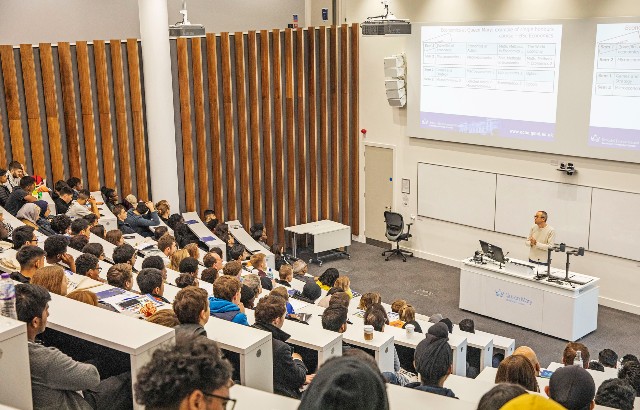Interdisciplinary research should be central to student experience
Professor Stephanie Marshall, Vice-Principal (Education) at Queen Mary University of London has written for Times Higher Education on how undergraduates can benefit and contribute to the pipeline of interdisciplinary research.

Our teaching and research landscape is changing as interdisciplinarity becomes one of the sector’s hot topics. This fusion of academic disciplines matters because the answers to some of the world’s biggest problems are unlikely to come from any one subject or specialism. The brightest minds, from many fields, will need to combine to solve these problems.
If there is a collective understanding of how important interdisciplinary research is to the future, we must ask what we can do to support it. Engaging students in research and building the pipeline of tomorrow’s researchers is critical, and it needs to start the moment students set foot on campus, including on interdisciplinary projects.
Unsurprisingly, collaboration is key to achieving this. Co-teaching is an interdisciplinary practice that has enormous benefits. Or it can be delivered by a single educator, who enables students to see a topic from perspectives beyond their own discipline. The humanities are a great example. Students learning about climate change must think about the scientific, geographical, political and cultural dimensions of this pressing issue, as well as what skills are needed to tackle this key issue.
Similarly, co-creation across different disciplines is beneficial when designing syllabuses and case studies for students, even before teaching occurs. While pedagogical techniques such as co-teaching are valuable, interdisciplinary teaching isn’t at its most effective when done on the fly. It should be meticulously thought out and prepared, which ought to be the case if it’s a component of a university’s institutional strategy. One of our own examples is a project that embeds analysis of climate change into the mathematics curriculum, with students working as co-creators. The work spans multiple maths modules, so many of our students benefit from this wider view of a pressing issue and are brought into discussions they might not have considered before. They also boost their employability in an increasingly green economy.
Elective modules centred on interdisciplinary issues are another effective strategy to engage students at an early stage. This might be more difficult to implement with some of the necessary core courses, but that doesn’t stop programme directors from adding viewpoints or materials from another subject. Art or literature can be used to explore biology and gender, for example. Interdisciplinarity is all about diverse perspectives and unique expertise colliding. And on a larger scale, that should be what university is all about, as it’s the best way of achieving real-world impact either through research or students themselves.
Introducing students to interdisciplinary research and teaching is especially important at the early stages of undergraduate study. It is already prevalent among postgraduate programmes and in the final years of undergraduate programmes. If students arrive at university and are immediately exposed to ideas and teaching outside their chosen area, rather than offered a selected “sidebar” of interdisciplinary options, then there is a consistent journey of interdisciplinary teaching through their time at university. They can then enter either the workforce or the world of academia as far more rounded and knowledgeable individuals.
Given its importance, higher education institutions and their leadership have a responsibility to embed interdisciplinary research into a university’s culture. In Queen Mary’s case, we have a number of University Research Institutes (URIs) taking on globally important interdisciplinary research challenges that are too big for one school alone, supported by unique research assets and infrastructure. One example is our Digital Environment Research Institute, which houses cutting-edge AI research. The institute is something we are enormously proud of, and it will provide an important foundation as we strive to address some of the major challenges facing society through research. These URIs also give students the opportunity to engage with some of the most exciting research around. This could take the form of summer internships, for instance, that give students a platform to build on their aspirations or spark an interest in doing this sort of work themselves.
Queen Mary has also established five “research highways”, covering areas of research and teaching excellence including sustainability, lifelong health and accelerating innovation and invention. Their launch is a landmark moment for the university and will provide a framework for more collaboration to happen, and for existing research strengths to grow. They can build vital partnerships by helping our external partners and collaborators better understand where we have real and distinctive research excellence. By creating a focal point for internal, cross-faculty collaboration, we will be able to ask even more ambitious research questions and work together more effectively to attract the right partnership opportunities. Putting all of this together, we have a structure that aids achieving the unthinkable and breaking new ground through pioneering research. And of course, interdisciplinarity was front of mind in their creation, given that each highway relates to the big questions that affect us all.
No one in higher education is under the illusion that interdisciplinarity is easy to implement. It takes time, focus and resource. It might even require a complete culture overhaul. But it is in everyone’s interests that it is a staple of both a university’s strategy and the student experience.
This article first appeared in Times Higher Education on August 27th.
Related items

24 February 2025